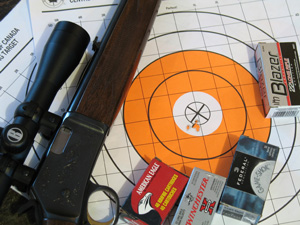
When it comes to squirrel hunting, I'm a rifleman. Sure I see the practicality in using a shotgun, especially in the early season when the foliage is up and the squirrels are in the trees; but, the truth is, I love .22 caliber rifles and I'll take them afield any chance I get.
Besides, a .22 is precise, inexpensive to practice with, and doesn't damage meat like a shotgun might when the shots are close. If you ask me, the .22 caliber rifle was made with the challenge of squirrel hunting in mind.
Even so, before you go out in the squirrel woods, you should give your squirrel rifle and your own shooting skills an honest assessment and then a tune-up. My own squirrel tune-up routine isn't very complicated or even expensive for that matter, but it is thorough. Accuracy and knowing your effective range are the primary objectives; everything else is a distant second.
This is because, as we all know, the vitals in a squirrel (the head or just behind the shoulder) are not exactly huge targets, especially when the animal is 40 to 50 yards away, and acting jittery. In fact, I can't think of another hunting weapon where accuracy is nearly as important. And if you hunt outside your effective range, accuracy will always suffer.
![]() Bonus Tip: Bushytail Basics & Squirrel Hunting Tips
Bonus Tip: Bushytail Basics & Squirrel Hunting Tips
Make the most of your squirrel rifle and skills and consider the following:
The Squirrel Rifle
 |
| Top rated Marlin 60 Rifle is one of the finest rimfire values you can find in a 22 long rifle. |
They say you can't make a silk purse out of a sow's ear. This old saying also applies to squirrel rifles too. The unit you start with should be dependable in the field, easy to carry in the woods, and above all inherently accurate.
The last characteristic is the most important; I'd much rather have a tack driving single-shot than a repeater that's much less exact. After all, if you place your bullet precisely, only one shot is needed.
What is accuracy in a squirrel rifle? After fine-tuning and practice, I can shoot half-inch groups or better at 50 yards with my favorite squirrel rifle. I've never needed much more than that although many rifles and shooters are capable of it.
Rifle Optics
There are legions of squirrel hunters who like to keep things simple. They'll go afield with iron sights and do quite well. I've got a lot of respect for those guys; heck, I once used iron sights too. But back then, when it came to longer shots, it was definitely a hit or miss proposition.
These days, I use a quality rifle scope on my .22. It allows me to aim more precisely and increase my maximum effective range on squirrels. Once you get the hang of using a scope, you'll never go back. Target acquisition, even on a moving squirrel, is fast.
 |
| The BSA® Sweet .22 Rifle Scope is specifically designed for the .22LR. |
Mine is a fixed 4 X 32 unit designed specifically for .22 caliber rifles. This means it has a 50-yard parallax setting and adjusts 1/4-inch per click at 100 yards too. It's lightweight and balances well on my rifle. Even more important, it's fogproof and waterproof.
Many riflemen are fans of variable scopes such as 3-9 X 32s. There's nothing wrong with them, and I suppose if an undisturbed squirrel gives you a chance to dial in to the higher power, there might even be an advantage to them. On the flip side, they tend to be a little more expensive, and I'm not sure that they provide significant practical benefits at typical squirrel hunting ranges.
In the end, personal taste and the terrain you hunt in should dictate your choice.
![]() Bonus Tip: Tips to Hunt Summertime Squirrels
Bonus Tip: Tips to Hunt Summertime Squirrels
Bullets
Most rim fire enthusiasts consider the .22 long rifle bullet the only one for eastern gray and fox squirrel. Many, myself included, prefer a copper-jacketed hollow point bullet weighing anywhere from 36 to 40 grains. With well-placed shots, these put squirrel down quickly — which is always an important consideration since a wounded squirrel might run off to a nest or knothole or even hang up high in the crotch of a tree.
 |
| Shoot several different cartridges while tuning your rifle to determine what brand and type your rifle prefers. |
When I'm about to fine tune my rifle for the field the first thing I do is buy several boxes of .22 cartridges that fall into the description previously mentioned. I try to get a variety of different bullet designs from various manufacturers.
I shoot groups with all of them until I determine which brand and type my rifle prefers. Of course, during testing all things should be equal including ranges, cleaned barrels, technique and good rests. After testing, you'll find one or two brands that will stand out as the best, meaning that they shoot tighter groups more consistently.
Take your time in this experimentation, and you'll be rewarded with a good hunting bullet that makes the most of your rifle's accuracy. After that, get to know what it does at different ranges. This selection process can make the difference between a full and empty game bag.
![]() Click here for a view of a rifle caliber chart.
Click here for a view of a rifle caliber chart.
Shooting Aids
 |
| A shooting stick system like the RedHead® 3-in-1 Tripod/Bipod/Monopod Shooting Stick is designed to meet the demands of every hunter and every hunting situation. |
When in the field, I'll always try to use a rifle rest. This makes even more sense when confronted with small targets such as squirrels. Limbs or tree trunks, cedar rail fences, and the like all work fine, but these days, more often than not, I carry a set of shooting sticks. They're handy as a pocket in a shirt and provide the rest required to make longer shots.
There are several excellent commercial models available but they're not difficult to make either; any on-line search will provide proven designs. In either case, make sure your sticks are long enough to allow you to make high angle shots too.
If you decide to use shooting sticks — and I highly recommend that you give them a try — it doesn't hurt to practice with them so that you don't waste time setting up when confronted with an undisturbed squirrel within rifle range.
Effective Squirrel Hunting Range
These processes and gear are meant to help you become more accurate with your rifle within practical squirrel hunting ranges. But what is practical hunting range?
For me, this means the maximum range that I can consistently hit a 2-inch circle in field conditions. With an offhand shot, your limit might be 30 yards or so. When shooting from a sitting position with a good rest you might be able to reach out to 75 yards or more. Naturally, it differs depending on the shooter, his rifle, and several other factors. But you'll never know any of this until you go out and do some serious paper punching.
I take along a laser range finder, paper targets, and a lot of ammunition to determine my limits. You can forego the rangefinder, but it is nice. Some metallic rim fire targets are also just about the right size and fun to practice on.
The point is if you know your effective range, you're far more likely to make clean kills. If a squirrel is outside of that distance, you then have a good idea how much of a stalk you need to make before it's inside your practical range.
Final Verdict
Few game animals challenge the small-bore marksman like bushytails. They're skittish, small, and crafty. To be consistently successful, you need to stack the odds in your favor. A simple tune-up like this can make all the difference when your only shot of the day is sitting unawares on a high limb some 60 yards away. Give it a try. Your game bag will thank you.
- 16142 views

